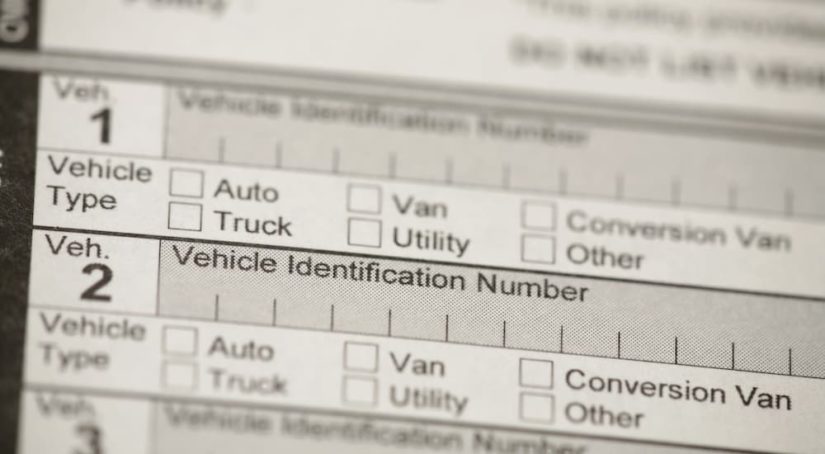Every car manufactured in the past 40 years comes with a unique 17-digit Vehicle Identification Number (VIN) stamped in several strategic areas. This code is used to track the vehicle from the day it is built throughout its entire life, identifying it in legal documents and vehicle history reports. You can see the VIN for your car by looking at the base of the windshield, but it is also engraved in a few other hidden locations to make sure that no one tries to change the number if the car is stolen or totaled.
While most drivers are familiar with the idea of a VIN as a way to identify a car, not everyone is aware of just how much information is contained in these 17 digits. If you understand the code, a VIN can tell you everything from when and where a vehicle was manufactured, to its body style and engine type. Running a VIN check is also a critical part of buying any used car, as it will let you know if the vehicle was salvaged, stolen, or has any open recalls. Given just how valuable a VIN is, it can be difficult to imagine how drivers possibly got along without them for so long.
Bringing Order to Chaos: The Evolution of the VIN
Serial numbers are such an integral part of modern life that it might surprise you just how recent an invention they are. Up until the Industrial Revolution, every item was handmade and unique, so there was no need for numbers to tell them apart. It wasn’t until mass production geared up in the early 1900s that serial numbers became necessary, and you could still find cars without serial numbers until the 1950s. Needless to say, not having a reliable way to identify vehicles made it difficult to keep track of who actually owned a car or determine the vehicle’s actual history. As cars became a universal feature of American life in the 1950s, the Vehicle Identification Number was introduced to make the oversight of the industry possible.
The first serial numbers were applied to vehicles in the early 1900s, but these were simply internal manufacturer codes. Often the engine, frame, and other major components would all be numbered separately, and there was no standardization between different manufacturers. Serial number formats were even regularly changed depending on the factory’s requirements, without regard for the eventual drivers’ needs, and were often placed on easily-removable number plates rather than engraved on the chassis. The idea of a standard Vehicle Identification Number that would follow the vehicle for life was introduced in 1954 when the US government worked with major automobile manufacturers to ensure that all vehicles would be given a unique number.
However, it wasn’t that easy. Each manufacturer created its own system for numbering the vehicles it produced, and those systems were changed several times in the early years. Even the number of digits was standardized until the United States Department of Transportation finally put its foot down in 1981. All cars built after that year have a 17-digit VIN that follows a set pattern that describes key aspects of the vehicle. Finally, the modern VIN was born, and it makes shopping for cars a much easier task than it used to be.
Breaking Down a VIN
All 17 digits in a VIN have their own distinct meaning, and while it requires access to a massive database of information to wring out every secret a VIN can tell you, you can pick out some key details pretty easily. With a little practice, you’ll be able to tell the manufacturer and model year of any vehicle with nothing more than a quick look at the VIN, and an experienced enthusiast can often pick out the VIN of well-known models or tell which engine a vehicle has. If you don’t feel up to remembering this much information, don’t worry–there are plenty of online VIN lookup tools that can give you all of this information at your fingertips.
Region and Manufacturer
The first three digits of a VIN describe the region where the vehicle was manufactured, as well as what brand manufactured it. Known as the World Manufacturer Identify (WMI), these three-digit codes are shared by both North American (FMVSS) and European (ISO 3779) VIN systems. The complete database of WMI codes includes over 33,000 entries and is maintained by the SAE, not the US government. Anyone producing road vehicles in the United States is required to obtain a unique WMI code, although manufacturers that build fewer than 2,000 vehicles a year have certain limitations on the codes they are given–if the third digit of the VIN is a “9” then you know the vehicle was produced by one of these smaller manufacturers.
The first digit represents the region where the vehicle was built, and is easy enough to remember:
- A-H = Africa
- J-R = Asia
- S-Z = Europe
- 1-5 = North America
- 6-7 = Oceania
- 8-9 = South America
This part of the code is particularly helpful if you know a manufacturer builds the same vehicle in different places and want an example from a particular country. Here are some common country codes to watch for when shopping for a car:
- J = Japan
- KL-KR = Korea
- L = China
- SA-SM = United Kingdom
- W = Germany
- 1, 4, 5 = United States
- 2 = Canada
- 3A-3W = Mexico
While modern automobile manufacturers are multinational and have production locations around the world, there are some common manufacturer codes that may be worth remembering:
- JHF-JHZ, JH1-JH5 = Honda Japan
- JN = Nissan Japan
- JT = Toyota Japan
- WA = Audi Germany
- WB = BMW Germany
- WD = Mercedes-Benz
- 1C = Chrysler, Jeep, Dodge, Ram America
- 1FA-1FT = Ford America
- 1G = General Motors America
Vehicle Description
The 4th through 8th characters describe the vehicle. Because of how many possible combinations there are, the secrets of these digits are generally only known to the manufacturer, but the details on some popular models are available. For instance, the well-known Mazda Miata generation codes are based on their VIN codes. An NC Miata, for instance, will have the letters “NC” as the 4th and 5th digits of its VIN. If you have a particular vehicle you are shopping for, looking up some model-specific VIN information can tell you quite a bit during your search.
Check Digit and Model Year
The 9th and 10th digits are not chosen by the manufacturer but are mandated by the government. The 9th digit is a special “check digit” that is used in a special formula to determine if a VIN is valid and can help the authorities catch a fake VIN. However, the formula is not a secret, and you can look it up for yourself to see if your VIN is valid.
The 10th digit reveals the model year of the vehicle. All vehicles sold in America must have an official model year for emissions testing, and this is listed in the VIN. However, since a single digit has to represent dozens of model years, the code is somewhat convoluted. It starts with the letter “A” to represent the 1980 model year (the first model year to require a modern 17-digit VIN) and then cycles through the alphabet and the numbers 1-9 (skipping the letters “I, O, Q, U, and Z” to prevent confusion with similarly-shaped letters and numbers). This means an “N” will represent a 2022 model, and a “P” will represent a 2023 model.
Serial Number
Finally, the last seven digits of the VIN will make up the vehicle’s unique serial number and reveal what plant the vehicle was manufactured in. Because all of the previous digits describe the manufacturer and type of vehicle, they will be the same for every vehicle of that particular model year and configuration. It is the last seven digits that will tell different vehicles of the same type apart. While there isn’t much secret information hidden here, it is one of the most important parts of the VIN.
What Is Your Car’s VIN Saying?
It may not be necessary to memorize how to fully decode a VIN, but knowing just how much information is present can be a helpful tool when shopping for a new car. Running a VIN history to check for open recalls and other aspects of a vehicle’s history is a critical step in ensuring that you are buying a used car that you can count on. However, even if you are shopping for a new car, being able to tell at a glance where a vehicle was made or what engine it has can be useful when sorting through your options. You might even want to decode the VIN of your current vehicle to get some practice––who knows what secrets are hiding in those 17 digits?



